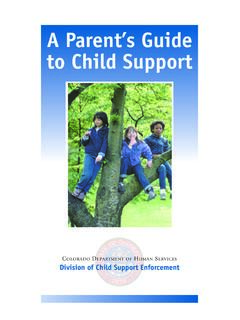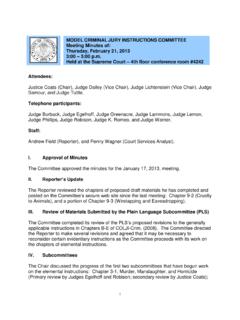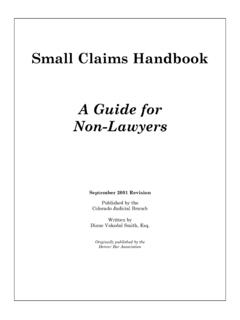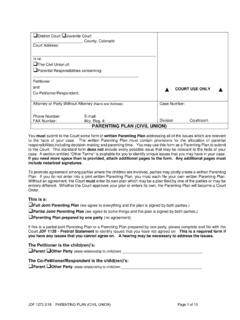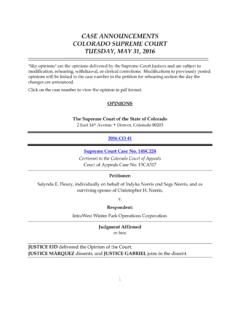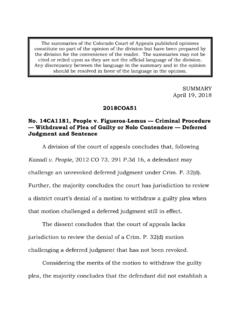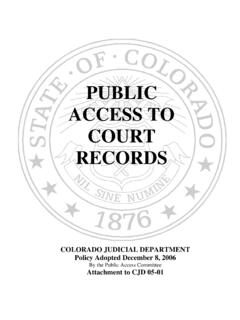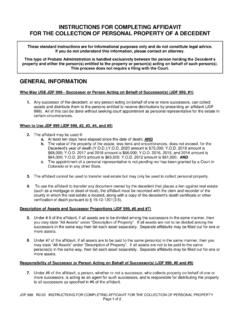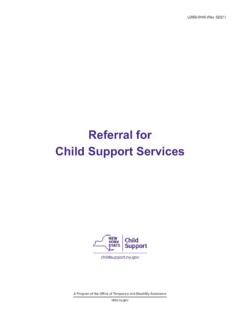Transcription of COLORADO CHILD SUPPORT GUIDELINE
1 JDF 1822 R10/21 Instructions for Completing Worksheets A and B Page 1 of 20 COLORADO CHILD SUPPORT Guidelines (For cases on or after July 1, 2021 only) Revised October 2021 1. Preface The CHILD SUPPORT Guidelines for COLORADO were developed by the COLORADO CHILD SUPPORT Commission and enacted by the COLORADO General Assembly. As specified in the statute, the Guidelines have three objectives: 1) To establish as state policy an adequate standard of SUPPORT for children, subject to the ability of parents to pay; 2) To make awards more equitable by ensuring more consistent treatment of persons in similar circumstances; and 3) To improve the efficiency of the court process by promoting settlements and giving courts and the parties guidance in setting the levels of awards.
2 The Guidelines can be found in 14-10-115, COLORADO Revised Statutes ( ), and are consistent with other provisions of that section which place a duty for CHILD SUPPORT upon either or both parents based on their respective financial resources, the financial resources of the CHILD , the needs of the custodial parent, the physical and emotional condition of the CHILD , and the standard of living the CHILD would have enjoyed had the marriage or civil union not been dissolved. The COLORADO CHILD SUPPORT GUIDELINE is based on an Income Shares Model. This model provides an objective basis for determining the average costs of children in households across a wide range of incomes. Because household spending on behalf of children is intertwined with spending on behalf of adults for most expenditure categories, it is difficult to determine the proportion allocated to children in individual cases, even with exhaustive financial affidavits.
3 However, a number of authoritative economic studies provide estimates of the average amount of household expenditures on children in intact households. These studies have found that the proportion of household spending devoted to children is systematically related to the level of household income and to the number and ages of children. Based on this economic evidence, the COLORADO CHILD SUPPORT Guidelines calculate CHILD SUPPORT based on each parent s share of the amount estimated to have been spent on the CHILD if the parents and CHILD were living in an intact If one parent has physical care for 273 or more overnights per year, the amount calculated for that parent is presumed to be spent directly on the CHILD . For the other parent, the calculated amount establishes the level of CHILD SUPPORT .
4 For cases with split or third party physical care, or extensive sharing of physical care, each parent s calculated share of CHILD SUPPORT is adjusted by the time spent with the CHILD (ren). 2. Use of The GUIDELINE The COLORADO CHILD SUPPORT Guidelines apply as a rebuttable presumption to all CHILD SUPPORT orders in COLORADO , except as discussed below. The Guidelines must be used for temporary and permanent orders, and for separations, dissolutions, and SUPPORT decrees arising despite non-marriage or non-civil union of the parties. The Guidelines must be used by the Court as the basis for reviewing the adequacy of CHILD SUPPORT levels in non-contested cases as well as contested hearings. The Court may exercise broad discretion in deviating from the Guidelines in cases where application would be inequitable to one of the parties or to the CHILD .
5 In cases where the award deviates from the Guidelines, however, the Court must provide written or oral findings of fact to substantiate the deviation. 1 For a detailed explanation of the Income Shares Model and the underlying economic evidence used as the basis for the COLORADO CHILD SUPPORT GUIDELINE , see Robert G. Williams, Development of Guidelines for CHILD SUPPORT Orders (National Center for State Courts: Denver, September 1987) JDF 1822 R10/21 Instructions for Completing Worksheets A and B Page 2 of 20 The CHILD SUPPORT Guidelines include a schedule of basic CHILD SUPPORT obligations that establishes the recommended amount of CHILD SUPPORT based on the number of children and parties incomes. However, there are two low-income adjustments.
6 When the obligor s (the parent ordered to pay CHILD SUPPORT ) monthly adjusted gross income is equal to or less than $650, the Guidelines provide for a minimum order of $10 per month, regardless of the number of children between the parties and regardless of how many overnights each parent cares for the children. When the obligor s monthly adjusted gross income is equal to or less than $1, but more than $650, the Guidelines require the obligor pay $ per month for one CHILD , $ per month for two children, $ per month for three children, $ per month for four children $ per month for five children, and $ per month for six or more children. The monthly CHILD SUPPORT obligation will be reduced if the custodial parent receives periodic disability benefits granted by the federal Old-age, Survivors, and Disability Insurance Act (also known as Social Security Disability Insurance or SSDI ) on behalf of dependent children due to the disability of the noncustodial parent.
7 The monthly CHILD SUPPORT obligation will also be reduced if the custodial parent receives employer-paid retirement benefits from the federal government on behalf of dependent children due to the retirement of the noncustodial parent. The reduction will be equal to the amount of the benefits. The monthly CHILD SUPPORT obligation can also be adjusted to include a share of the work-related and education-related CHILD care costs, health insurance, extraordinary medical expenses, and other extraordinary adjustments as described in the statute in subsections (9) to (11), if, after these adjustments are made, the obligor's CHILD SUPPORT amount (basic obligation plus share of adjustments) does not exceed twenty percent of the obligor's adjusted gross income.
8 If the obligor s calculated SUPPORT amount exceeds twenty percent of the obligor s adjusted gross income, the CHILD SUPPORT obligation must be capped at twenty percent of the obligor s adjusted gross income. The minimum GUIDELINE amount for obligors earning less than $1,500 per month shall not apply when each parent keeps the children more than ninety-two overnights each year. In no case, however, shall the amount of CHILD SUPPORT ordered to be paid exceed the amount of CHILD SUPPORT that would otherwise be ordered to be paid if the parents did not share physical custody. The Guidelines provide calculated amounts of CHILD SUPPORT up to a combined adjusted gross income level of $30, per month ($360, per year). For cases that exceed this level, the court may decide on a case- by-case basis, but may not order less than the amount on the schedule for $30, 3.
9 determination of CHILD SUPPORT Amount To calculate CHILD SUPPORT for children who are under 19 or still in high school, or disabled, use: Worksheet A when one parent maintains physical care of the CHILD for 273 or more overnights per year [see (4)(I) below]; use Worksheet B if each parent shares physical care of the CHILD for more than 92 overnights per year [see (4)(J) below]. (A) Income 1) Definition. For purposes of this GUIDELINE , income is defined as actual gross income of the parent, if employed to full capacity or potential income if unemployed or underemployed. Gross income of each parent should be determined as specified below and entered on Line 1 of the appropriate worksheet. 2) Gross income. Gross income includes income from any source and includes, but is not limited to, income from salaries; wages, including tips declared by the individual for purposes of reporting to the federal internal revenue service or tips imputed to bring the employee s gross earnings to the minimum wage for the number of hours worked, whichever is greater; commissions; payments received as an independent JDF 1822 R10/21 Instructions for Completing Worksheets A and B Page 3 of 20 contractor for labor or services, which payments must be considered income from self-employment; bonuses; dividends; severance pay; pensions and retirement benefits; royalties; rents; interest; trust income; annuities; capital gains.
10 And moneys drawn by a self-employed individual for personal use that are deducted as a business expense, which moneys must be considered income from self-employment; social security benefits, including social security benefits actually received by a parent as a result of the disability of that parent or as the result of the death of the minor CHILD s stepparent; workers compensation benefits; unemployment insurance benefits; disability insurance benefits; funds held in or payable from any health, accident, disability, or casualty insurance to the extent that such insurance replaces wages or provides income in lieu of wages; monetary gifts; monetary prizes, excluding lottery winnings not required by the rules of the COLORADO Lottery Commission to be paid only at the lottery office; income from general partnerships, limited partnerships, closely held corporations, or limited liability companies, however, if a parent is a passive investor, has a minority interest in the company, and does not have any managerial duties or input, then the income to be recognized may be limited to actual cash distributions received; alimony or maintenance (spousal/partner SUPPORT ) received; and overtime pay only if the overtime is required by the employer as a condition of the employment.
